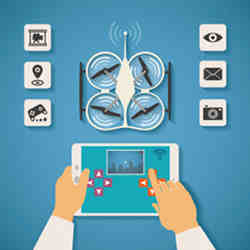
As drones whirl, swirl, and dart into everyday life, there are growing concerns about public safety. The idea that these devices could crash into buildings, trees, power lines, and even other flying things—including commercial aircraft and other drones—falls somewhere between alarming and terrifying. "The last thing people want is to see is drones falling from the sky and causing injuries, damage, and death," says Sebastian Scherer, a systems scientist at Carnegie Mellon University’s Robotics Institute.
Researchers and engineers are working to design unmanned aerial vehicles (UAVs), also known as drones, that can fly more effectively, sense their surroundings, and take evasive or corrective action in the event of a problem or system failure. Although most drones now are flown by remote pilots or operators, the emergence of automated and autonomous vehicles—likely within the next five years—will increase the need for better and safer systems. These free-range drones would require little, if, any human interaction.
"Right now, people are flying drones mostly by line of sight from one waypoint to another, so there isn’t a great need for navigation systems," says Helen Greiner, CEO and founder of drone manufacturer CyPhy Works. However, as drones are used for an increasing variety of purposes, including package delivery, the need for more automated systems grows. "There will be a need for sense and avoid technology."
Making Drones Deliver
A starting point for any discussion about drones is to recognize that today’s transportation and delivery systems all have their inherent risks; vehicles collide, and damage and death result (typically due to human error). Automated and autonomous drones may actually reduce risks and make conditions safer. What is more, "Lightweight drones carrying small packages would typically pose minimal risk," Greiner says. The CyPhy drone, for example, flies above tree lines and telephone poles and, when it reaches its destination, lowers a package using a chain and release mechanism.
Yet moving from human-controlled drone systems to automated systems requires better blade designs, a greater use of sensors, and more sophisticated software. Global Positioning System (GPS) and cellular guidance systems can guide a drone to a particular coordinate, but there is a need for complementary systems, Scherer points out; otherwise, a GPS outage could lead to a stranded drone. Consequently, researchers are exploring other technologies—including LIDAR, video cameras, ultrasound, and velocity detectors—that could make sense of an environment and the objects in it for a drone. Greiner notes that cameras tied into visual analytics could identify objects, connect to the cloud for processing power, and respond accordingly.
Not surprisingly, all these technologies offer tradeoffs. LIDAR is highly effective at detecting trees and other objects, but it cannot always detect strung cables, like telephone and other utility wires. Cameras are subject to fogging and blockage from dust or debris, and ultrasound can produce false positives and does not see trees particularly well. Although designers likely will incorporate multiple technologies into any particular drone design, it is not currently possible to build a system that uses all these technologies on a small flying machine. "You might have to pay a big weight penalty for being able to detect all wires," Scherer explains.
The Sky is The Limit
It is wise to question some basic assumptions about drone systems and safety. For instance, "It might be okay if a drone occasionally hits a tree, building, or wires," Scherer explains. "If we build a lightweight vehicle and it is able to adjust, adapt and recover, there really isn’t a problem." The key, he says, is to build in sensors and software that interpret events in real time and adjust accordingly. This may mean that a drone enters a reassessment mode if a collision or other problem occurs.
Likewise, researchers are exploring safer blade designs and even the use of parachute-type devices in the event a vehicle fails completely. They also are exploring how to connect drones into small fleets. One option, Greiner points out, is automatic dependent surveillance–broadcast (ADS-B), a type of GPS technology airplanes use to maintain a safe distance from one another. At the Georgia Tech Research Institute, chief scientist Lora Weiss and other researchers are building drone fleets. In the future, Weiss says, "Human operators must be able to provide high-level task descriptions, allowing the systems to figure out for themselves how to dynamically form teams and autonomously collaborate to complete tasks."
Scherer predicts semi-autonomous drones will appear in the next few years, and free-range drones will likely fly within five to seven years. "We are close to designing and building drones that can fly in an autonomous way."
Samuel Greengard is an author and journalist based in West Linn, OR.



Join the Discussion (0)
Become a Member or Sign In to Post a Comment